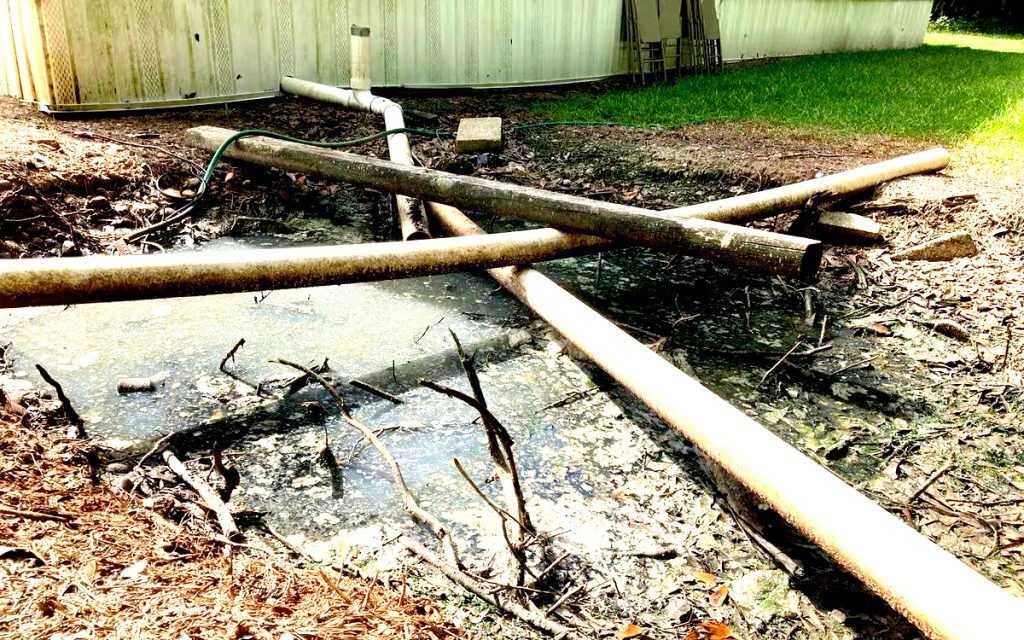Sewage overflow in Lowndes County.
Children in Black Belt homes without working sewage systems were more likely to have pathogens in their bodies if they rely on well water, a recent study found.
Researcher Drew Capone, professor of Public Health at Indiana University, said the sewage is likely infiltrating drinking water downstream from the homes in rural parts of south Alabama because of the lack of sanitation infrastructure.
“If human waste isn’t being safely managed and treated like it isn’t, unfortunately, in certain parts of the Black Belt, and it’s getting into the environment, it can be transported through the soil into drinking water in groundwater,” he said.
Many areas are too spread out for large, central sewer lines and the heavy clay soil doesn’t allow water to seep into the ground easily, causing many septic tank systems to fail. As a result, many homes use “straight piping,” sending sewage from their homes into the ground.
The pathogens may cause diarrhea in children, along with concerning long-term effects like cognitive deficits and stunted growth, according to Capone.
Researchers sampled 352 children from Black Belt homes that lacked sanitation infrastructure as they looked for the DNA of pathogens like E. Coli and in the children’s’ stool.
The study, whose results were published by the CDC this month, found a connection between the lack of sewage systems in homes and the presence of bacteria in children’s bodies for children who drank well water. Children who drank municipal water were not as likely to have the pathogens in their bodies. Contaminated soil and food are also concerns for spreading pathogens to humans, according to the report.
Due to a mix of poverty and small populations and challenging geology, sewage issues in the Black Belt have persisted for years, although the issue has gained attention in recent years.
Lowndes, a rural county next to Montgomery, had earned international attention in recent years and even a visit from a United Nations delegation after a report found a resurgence of hookworm linked to lack of sanitation.
Biden’s EPA Administrator Michael Regan visited Lowndes twice in the past two years. And earlier this year, the Black Belt became a test case for the federal government, as federal agencies used civil rights law to prompt state agencies to improve sanitation in the Black Belt.
The U.S. Departments of Justice and Health and Human Services said their investigation showed that Alabama had engaged in “a consistent pattern of inaction and/or neglect concerning the health risks associated with raw sewage,” in Lowndes County.
In May, the Civil Rights Division of the U.S. Department of Justice and the Health and Human Services Office for Civil Rights announced Alabama had agreed to fix the sewage crisis in Lowndes County and halted the investigation into the Alabama Department of Public Health.
However, Lowndes is far from alone. Black Belt communities outside of Lowndes County continue to face similar problems.
Capone said most of the research on pathogens in children resulting from poor sewage systems has been done overseas, leaving little data on the impact of such exposure for children in the United States. The prevalence of pathogens in Alabama children was lower than what is usually seen in other low and middle-income countries where sewage systems are a problem, he said.
In a previous era, 50 or 150 years ago, about a quarter to half of children in the American South had intestinal pathogens like hookworm, so public awareness of such diseases was higher then, said Capone. Children exposed to pathogens through sewage in the U.S. live in rural areas without properly working sewage systems, such as in the Black Belt or in rural parts of other states like Indiana, where he works.
“Really this only remains a public health concern in these low-income, rural, isolated communities that still have really poor sanitation.”










